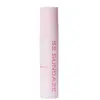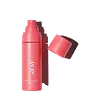What's inside
What's inside
 Key Ingredients
Key Ingredients

 Benefits
Benefits

 Concerns
Concerns

No concerns
 Ingredients Side-by-side
Ingredients Side-by-side

Water
Skin ConditioningRosa Damascena Flower Water
MaskingPaba
Hydroxyapatite
AbrasiveTerephthalylidene Dicamphor Sulfonic Acid
UV AbsorberBenzophenone-4
UV AbsorberEthylhexyl Methoxycinnamate
UV AbsorberButyl Methoxydibenzoylmethane
UV AbsorberBenzophenone-3
UV AbsorberPhospholipids
Skin ConditioningButylene Glycol
HumectantZinc Oxide
Cosmetic ColorantTitanium Dioxide
Cosmetic ColorantMethylene Bis-Benzotriazolyl Tetramethylbutylphenol
UV FilterAloe Barbadensis Leaf Extract
EmollientRubus Idaeus Extract
Skin ProtectingHyaluronic Acid
HumectantTocopherol
AntioxidantAscorbic Acid
AntioxidantDipotassium Glycyrrhizate
HumectantOryza Sativa Bran Water
MaskingSilica
AbrasiveSodium Benzoate
MaskingPhenoxyethanol
PreservativeWater, Rosa Damascena Flower Water, Paba, Hydroxyapatite, Terephthalylidene Dicamphor Sulfonic Acid, Benzophenone-4, Ethylhexyl Methoxycinnamate, Butyl Methoxydibenzoylmethane, Benzophenone-3, Phospholipids, Butylene Glycol, Zinc Oxide, Titanium Dioxide, Methylene Bis-Benzotriazolyl Tetramethylbutylphenol, Aloe Barbadensis Leaf Extract, Rubus Idaeus Extract, Hyaluronic Acid, Tocopherol, Ascorbic Acid, Dipotassium Glycyrrhizate, Oryza Sativa Bran Water, Silica, Sodium Benzoate, Phenoxyethanol
Water
Skin ConditioningPhenylbenzimidazole Sulfonic Acid
UV AbsorberTerephthalylidene Dicamphor Sulfonic Acid
UV AbsorberPolysilicone-15
UV FilterMethylene Bis-Benzotriazolyl Tetramethylbutylphenol
UV FilterPropanediol
SolventButylene Glycol
HumectantHyaluronic Acid
HumectantVetiveria Zizanoides Root Extract
PerfumingSaccharomyces/Rice Ferment Filtrate
Skin ConditioningWithania Somnifera Root Extract
Skin ConditioningPrunus Yedoensis Leaf Extract
Skin ConditioningPhenoxyethanol
PreservativeSodium Gluconate
Skin ConditioningWater, Phenylbenzimidazole Sulfonic Acid, Terephthalylidene Dicamphor Sulfonic Acid, Polysilicone-15, Methylene Bis-Benzotriazolyl Tetramethylbutylphenol, Propanediol, Butylene Glycol, Hyaluronic Acid, Vetiveria Zizanoides Root Extract, Saccharomyces/Rice Ferment Filtrate, Withania Somnifera Root Extract, Prunus Yedoensis Leaf Extract, Phenoxyethanol, Sodium Gluconate
 Reviews
Reviews

Ingredients Explained
These ingredients are found in both products.
Ingredients higher up in an ingredient list are typically present in a larger amount.
Butylene Glycol (or BG) is used within cosmetic products for a few different reasons:
Overall, Butylene Glycol is a safe and well-rounded ingredient that works well with other ingredients.
Though this ingredient works well with most skin types, some people with sensitive skin may experience a reaction such as allergic rashes, closed comedones, or itchiness.
Learn more about Butylene GlycolHyaluronic acid is naturally found in healthy skin. It is a humectant, meaning it draws moisture to your skin.
This ingredient helps hydrate, soothe, and protect the skin.
What makes hyaluronic acid so hydrating? It has the capacity to bind or hold large amounts of water.
Fun fact: It is already naturally found in our bodies, such as the fluids of our eyes and our joints.
Studies find this ingredient to have anti-inflammatory and anti-microbial properties. This can help speed up wound-healing.
Hyaluronic acid can be irritating if the molecule has a low-molecular weight, or if the molecules are small.
One study found low-molecular weight hyaluronic acid to be pro-inflammatory, meaning some people may experience irritation. This is because our bodies use hyaluronic acid in the wound-healing process to signal to our bodies, via irritation, that something needs healing.
The same study found high-molecular weight hyaluronic acid to be anti-inflammatory.
These are some other common types of Hyaluronic Acid:
Learn more about Hyaluronic AcidMethylene Bis-Benzotriazolyl Tetramethylbutylphenol (Tinosorb M) is a hybrid and broad-spectrum UV ingredient. It is both a UV absorber and filter.
UV absorbers are an agent that absorbs UV rays. They protect your skin by using chemical reactions to convert UV rays into heat and energy. UV filters physically reduce the amount of UV rays from reaching your skin.
Tinosorb M covers a range of 280-400 nm and is photostable. This ingredient is neither oil or water soluble.
Tinosorb M is not available in the US. However, it is available in the EU and Asia.
It's sister, Tinosorb S, is set to be approved in the US by late 2025 (fingers crossed!).
Learn more about Methylene Bis-Benzotriazolyl TetramethylbutylphenolPhenoxyethanol is a preservative that has germicide, antimicrobial, and aromatic properties. Studies show that phenoxyethanol can prevent microbial growth. By itself, it has a scent that is similar to that of a rose.
It's often used in formulations along with Caprylyl Glycol to preserve the shelf life of products.
Ecamsule is a UV-A absorber (290–400 nm) patented by L'Oreal. It is derived from benzylidene camphor, making it highly photostable.
Ecamsule is able to prevent UV from reaching the skin. It absorbs UV and releases it as thermal energy.
It does this by:
The pH of ecamsule needs to be neutralized due to it being an acid. Triethanolamine is a pH adjusting ingredient often used with ecamsule.
This sunscreen ingredient is approved for use in the EU, Canada, and Asia. In the US, you will only find this ingredient in select L'Oreal products.
Learn more about Terephthalylidene Dicamphor Sulfonic AcidWater. It's the most common cosmetic ingredient of all. You'll usually see it at the top of ingredient lists, meaning that it makes up the largest part of the product.
So why is it so popular? Water most often acts as a solvent - this means that it helps dissolve other ingredients into the formulation.
You'll also recognize water as that liquid we all need to stay alive. If you see this, drink a glass of water. Stay hydrated!
Learn more about Water